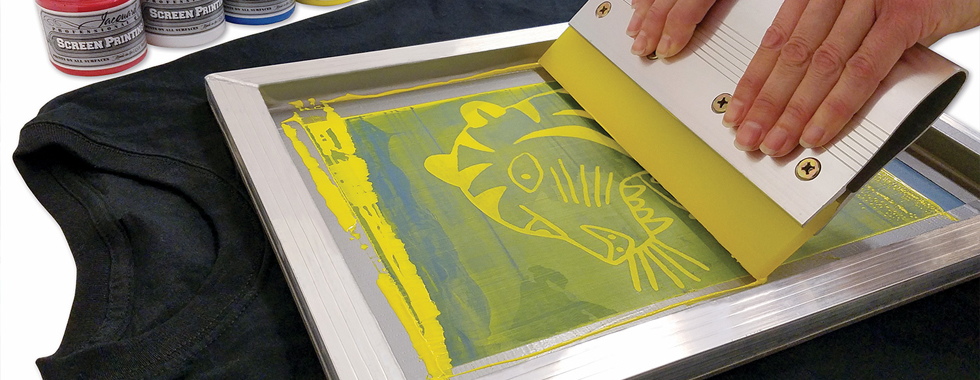The Necessary Guide to Recognizing Screen Printing and Its Versatile Utilizes
Screen printing has an abundant background that goes back to old times, advancing right into a sophisticated technique utilized throughout various sectors today. This guide discovers the complexities of the screen printing procedure, detailing its applications in advertising and marketing, style, and home style - 10:9 Design near me. Understanding these basics can open creative possibility for both artistic and industrial tasks. The adhering to sections will reveal essential ideas and strategies to enhance one's screen printing ventures
The Background of Screen Printing
Screen printing has origins that trace back centuries, its development shows the technological and creative advancements of various cultures. Coming from in old China, the method was originally utilized for enhancing fabrics and later infect Japan, where it came to be integral to Ukiyo-e woodblock printing. The method shifted to Europe in the 18th century, where it acquired appeal among artisans and business printers. The development of image solution in the 20th century revolutionized screen printing, permitting more elaborate designs and better performance. Artists like Andy Warhol even more drove its popularity, using the tool to produce famous works that combined commercialism and fine art. By the late 20th century, screen printing had actually developed itself as a flexible technique, employed in vogue, marketing, and art. Today, it remains to progress, integrating electronic modern technology and expanding its applications across different sectors.
The Screen Printing Refine Explained
Screen printing transforms creative visions right into concrete designs via a collection of precise steps. Originally, a photo is produced and after that transferred onto a screen, commonly made from fine mesh fabric extended over a framework. A light-sensitive solution is used to the screen, which is revealed to light, hardening in areas not covered by the picture. After rinsing the unhardened solution, a stencil is created.
Next, the screen is positioned over the substratum, whether it be fabric, paper, or another product. Ink is then pushed with the open locations of the pattern making use of a squeegee, depositing the layout onto the substrate listed below. This procedure can be duplicated for multiple shades, requiring separate displays for each and every shade. Finally, the published product is healed utilizing warmth to guarantee the ink sticks effectively, resulting in a durable, dynamic layout on-line.
Types of Screen Printing Techniques

In addition, specialty methods, such as discharge screen printing, remove dye from the textile to produce softer prints, while aluminum foil screen printing applies metal foil to accomplish a glossy surface (10:9 Design Embroidery). Each strategy offers unique attributes, dealing with numerous innovative needs and manufacturing ranges, eventually increasing the possibilities within the screen printing domain
Applications of Screen Printing in Different Industries

Additionally, the signs and advertising industries make use of screen printing for producing attractive screens and banners. This approach enables for vibrant colors and complex layouts that record attention. In electronics, screen printing is used for using conductive inks to circuit boards, vital for component connections. The home style sector embraces screen printing to produce distinctive designs on textiles and wall art. Generally, screen printing works as an essential device across diverse fields, improving products with individualized and visually enticing graphics.
Tips for Effective Screen Printing Projects
While carrying out a screen printing project, mindful interest to detail can significantly enhance the final outcome. Picking top notch products is important; this includes the screen, inks, and substrates. Using suitable mesh counts can influence ink deposition and detail resolution. Preparation is similarly crucial; comprehensive cleaning of displays and appropriate exposure times ensure crisp prints.
Next, exact registration is critical for multi-color prints. Using alignment devices browse around this web-site can aid achieve specific layering. Furthermore, screening prints on scrap products prior to production helps determine prospective issues without throwing away resources.

Regularly Asked Inquiries
What Materials Are Best for Screen Printing on Material?
Cotton and polyester blends are optimal for screen printing on material as a result of their toughness and ink absorption. In addition, specialized materials like silk or canvas can produce special structures and surfaces, enhancing the overall layout top quality.
Exactly how Do I Clean and Maintain Screen Printing Equipment?
To clean up and maintain screen printing equipment, one must frequently wash screens with appropriate solvents, evaluate mops for wear, lube moving parts, and shop all things in a dry, dust-free environment to lengthen their lifespan.
What Are the Environmental Effects of Screen Printing?
Screen printing can have significant ecological effects, consisting of chemical waste from solvents and inks, water usage throughout cleaning procedures, and power usage. Sustainable techniques and environment-friendly materials are vital for minimizing these adverse impacts.
Can Screen Printing Be Done at Home Successfully?
Screen printing can be efficiently done at home with the best materials and strategies. Hobbyists can develop quality prints, though success relies on their skill degree, equipment, and understanding of the process involved.
What Are the Prices Related To Starting a Display Printing Organization?

Beginning a screen printing service involves costs for equipment, materials, and workspace. Preliminary expenses typically range from a few hundred to several thousand dollars, depending on the range, high quality of machinery, and wanted manufacturing capacity.
Screen printing has an abundant history that dates back to ancient times, progressing right into a sophisticated method utilized throughout various markets today. Another technique, rotary screen printing, employs cylindrical screens, helping with continuous printing on textile rolls, thereby improving effectiveness for large productions. Additionally, specialty techniques, such as discharge screen printing, remove color from the textile to develop softer prints, while aluminum foil screen printing uses metallic aluminum foil to achieve a shiny finish. In the style field, screen printing is extensively made use of to produce vibrant designs on apparel, allowing brands to showcase their one-of-a-kind designs. Cotton and polyester blends are suitable for screen printing on material due to their toughness and ink absorption.